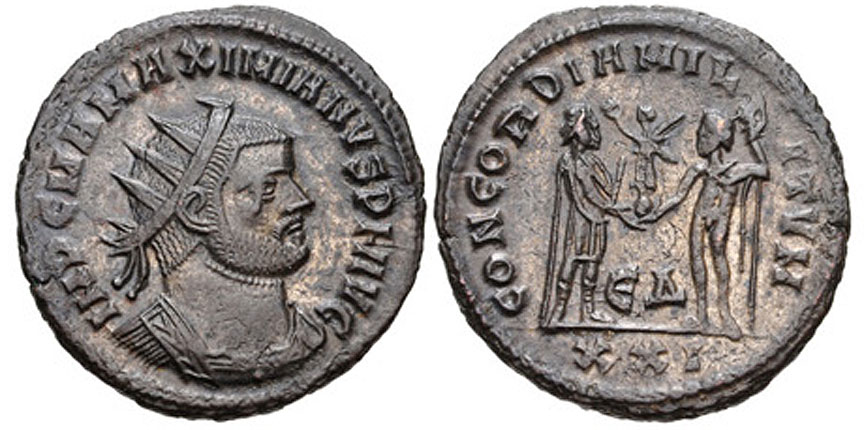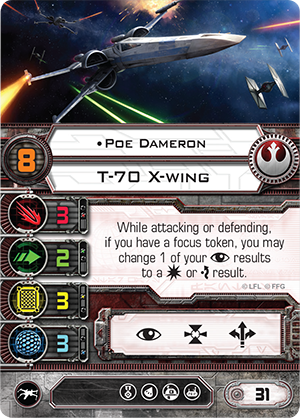Maximianus - Antoninianus
Click to see the details
market
| Subject | Maximianus |
| Reverse Type | Victory |
| Denomination | Antoninianus |
| Primary ID Type | RIC |
| Primary ID | 371 V |
| InscriptionObv | IMP C MAXIMIANUS |
| InscriptionRev | CONCORDIA MILITVM XXL |
| Material | Copper/Bronze |
| Earliest | 286 |
| Latest Possible Year | 305 |
| Size (mm) | 21 |
| Weight (gr) | 139 |
| Period | Imperial |
| Culture | Rome |
Notes:
Radiate bust right / soldier and emperor supporting Victory together.
Obverse:
Maximian (Latin: Marcus Aurelius Valerius Maximianus Herculius Augustus; c. 250 – c. July 310) was Roman Emperor from 286 to 305. He was Caesar from 285 to 286, then Augustus from 286 to 305. He shared the latter title with his co-emperor and superior, Diocletian, whose political brain complemented Maximian’s military brawn. Maximian established his residence at Trier but spent most of his time on campaign. In the late summer of 285, he suppressed rebels in Gaul known as the Bagaudae. From 285 to 288, he fought against Germanic tribes along the Rhine frontier. Together with Diocletian, he launched a scorched earth campaign deep into Alamannic territory in 288, temporarily relieving the Rhine provinces from the threat of Germanic invasion.
The man he appointed to police the Channel shores, Carausius, rebelled in 286, causing the secession of Britain and northwestern Gaul. Maximian failed to oust Carausius, and his invasion fleet was destroyed by storms in 289 or 290. Maximian’s subordinate, Constantius, campaigned against Carausius’ successor, Allectus, while Maximian held the Rhine frontier. The rebel leader was ousted in 296, and Maximian moved south to combat piracy near Hispania and Berber incursions in Mauretania. When these campaigns concluded in 298, he departed for Italy, where he lived in comfort until 305. At Diocletian’s behest, Maximian abdicated on May 1, 305, gave the Augustan office to Constantius, and retired to southern Italy.
In late 306, Maximian took the title of Augustus again and aided his son Maxentius‘ rebellion in Italy. In April 307, he attempted to depose his son, but failed and fled to the court of Constantius’ successor, Constantine (who was both Maximian’s step-grandson and also his son-in-law), in Trier. At the Council of Carnuntum in November 308, Diocletian and his successor, Galerius, forced Maximian to renounce his imperial claim again. In early 310, Maximian attempted to seize Constantine’s title while the emperor was on campaign on the Rhine. Few supported him, and he was captured by Constantine in Marseille. Maximian committed suicide in the summer of 310 on Constantine’s orders. During Constantine’s war with Maxentius, Maximian’s image was purged from all public places. However, after Constantine ousted and killed Maxentius, Maximian’s image was rehabilitated, and he was deified.
The man he appointed to police the Channel shores, Carausius, rebelled in 286, causing the secession of Britain and northwestern Gaul. Maximian failed to oust Carausius, and his invasion fleet was destroyed by storms in 289 or 290. Maximian’s subordinate, Constantius, campaigned against Carausius’ successor, Allectus, while Maximian held the Rhine frontier. The rebel leader was ousted in 296, and Maximian moved south to combat piracy near Hispania and Berber incursions in Mauretania. When these campaigns concluded in 298, he departed for Italy, where he lived in comfort until 305. At Diocletian’s behest, Maximian abdicated on May 1, 305, gave the Augustan office to Constantius, and retired to southern Italy.
In late 306, Maximian took the title of Augustus again and aided his son Maxentius‘ rebellion in Italy. In April 307, he attempted to depose his son, but failed and fled to the court of Constantius’ successor, Constantine (who was both Maximian’s step-grandson and also his son-in-law), in Trier. At the Council of Carnuntum in November 308, Diocletian and his successor, Galerius, forced Maximian to renounce his imperial claim again. In early 310, Maximian attempted to seize Constantine’s title while the emperor was on campaign on the Rhine. Few supported him, and he was captured by Constantine in Marseille. Maximian committed suicide in the summer of 310 on Constantine’s orders. During Constantine’s war with Maxentius, Maximian’s image was purged from all public places. However, after Constantine ousted and killed Maxentius, Maximian’s image was rehabilitated, and he was deified.
Period:
Imperial Rome. As the Roman Republic began to implode because of
corruption and infighting among powerful members of the Roman Senate, a new type of
Roman Republican coinage emerges, that of the military strongmen who dominated and
fought among each other before the final fall of the Republic. The drama surrounding
the fall of the Roman Republic is a story full of political intrigue, military action, betrayal,
murder and sex scandals. Different parts of this story have been told and retold by
ancient historians, modern day scholars, dozens of Hollywood movies and even an HBO
miniseries. All of the actors in this great drama, Crassus, Pompey, Julius Caesar, Brutus
and Cassius, Mark Antony and Cleopatra and the last man standing at the end of it all,
Octavian (later known as the first emperor of Rome, Emperor Augustus) all minted coins
during this time bearing their names and propaganda images supporting their factions
and political ideals.
Culture:
Ancient Rome. A famous catch phrase "Rome was not built in a day"
definitely applies to the Roman civilization. Rome stated as a series of small villages among the
famous seven hills of Rome along the river Tiber. Eventually through conquest, diplomacy, wise
policies of indirect rule and assimilation, the Romans were able to not only unify the Italian
peninsula, but though a series of brutal wars against regional powers established a great Empire
that spanned Europe, Asia and Africa, making the Mediterrean Sea and "Roman Lake."
All Roman coinage can generally be divided into eight time periods as described below. An interesting thing about Roman coins minted during these eight time periods is that you can literally see the "Rise and Fall" of the Roman Empire on its coinage as the sharp imagery and pure silver and gold coins of the Roman Republic and Early Imperial Period gradually devolves into crude, illegible and heavily debased coins of the "Barracks Emperors" and "Barbarian" Period.
All Roman coinage can generally be divided into eight time periods as described below. An interesting thing about Roman coins minted during these eight time periods is that you can literally see the "Rise and Fall" of the Roman Empire on its coinage as the sharp imagery and pure silver and gold coins of the Roman Republic and Early Imperial Period gradually devolves into crude, illegible and heavily debased coins of the "Barracks Emperors" and "Barbarian" Period.
Item created by: gdm
on 2016-08-14 12:55:22
Last edited by: gdm on 2016-08-14 16:33:05
If you see errors or missing data in this entry, please feel free to log in and edit it. Anyone with a Gmail account can log in instantly.
Last edited by: gdm on 2016-08-14 16:33:05
If you see errors or missing data in this entry, please feel free to log in and edit it. Anyone with a Gmail account can log in instantly.







